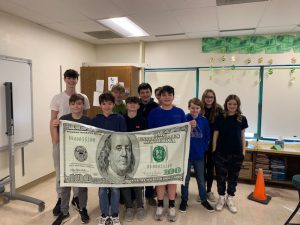
Sometimes it’s the little things that can turn into major issues for adults, as well as our students. Whether it’s balancing finances, saving for important purchases, planning for our future, or day-to-day living. At FFCS, middle school students are gaining invaluable experience in learning how budgeting can be critical as they grow older and how it will play a prominent role once they’ve graduated. Meet. Mr. Vunk. He’s currently the Fonda-Fultonville history and economics teacher for eighth-grade students.
As part of his class curriculum, he’s introducing an innovative way for students to apply their budgeting skill sets to better understand some of life’s everyday responsibilities. What might be taken for granted in terms of financial responsibility is turning into a fun and interesting project that engages today’s students to learn about financial literacy.
“We say that money does not have emotions,” said Mr. Vunk. “Studying economics, as it relates to all countries around the world, provides students the ability to connect America’s economic structure and government to other nations. In eighth grade, the study of economics becomes even more focused as they learn about the Great Depression. For students to connect to the struggles of individuals and families in the 1930s, they complete a project in which each student in a class receives a pre-made ‘life’ with the setting being 2023.”
As part of this unique project, students are asked to identify/study areas of their life, such as their profession, yearly income, family status, ages of kids, and fixed bills such as car payments, rent, student loans, etc. This project occurs every other day in the classroom so that on opposite days the connections to the Great Depression are made. In this way, there is a repeated flashback/forward between what is happening in our budget to those years ago.
In addition, topics students learn and need to apply to their budget include interest rates, inflation, credit cards, the stock market, and creating a healthy monthly budget which includes managing unexpected costs such as repairs. Students use a ledger to record all of their transactions to deposit income, withdraw money to pay bills, and maintain a current balance. Today’s students even learn about income and state tax and subtract that from their income. Another portion of the project is for students to understand the cost of variable expenses such as groceries, gasoline, clothing, entertainment, etc.
“The project is research-based and students are not provided with all of the information needed to complete their budgets,” shared Mr. Vunk. “Participating students are asked to seek assistance from other adults and/or research online. They are provided with and steered towards finding current economic charts and graphs as well as using the numerous free ‘calculators’ found online for determining credit card minimum payments and interest. This year, students were able to create a budget for six simulated months ranging from January through June.”
So, with a little assistance from history, economics, and financial literacy – – today’s students are learning more about fiscal responsibility and preparing for a time when balancing the budget will have an important effect on their future.
